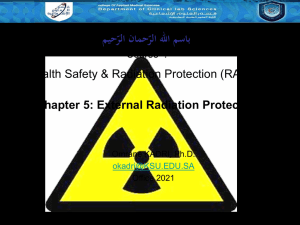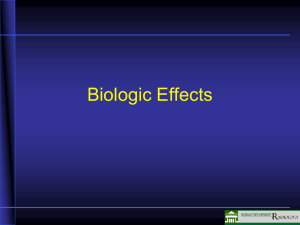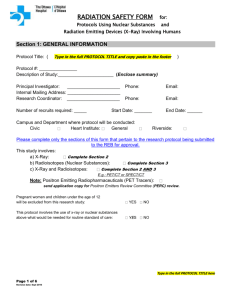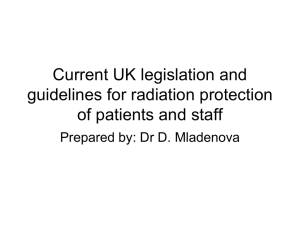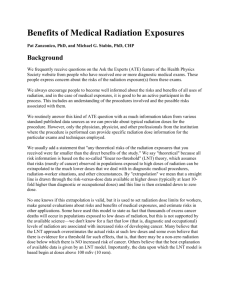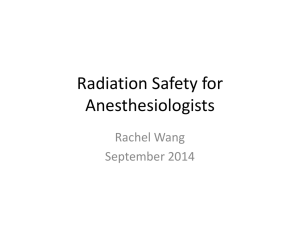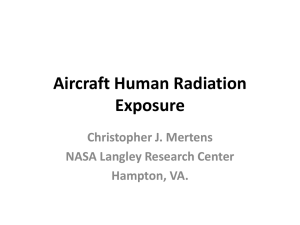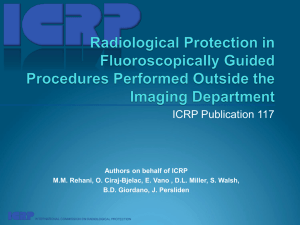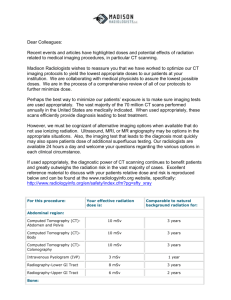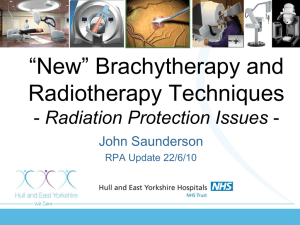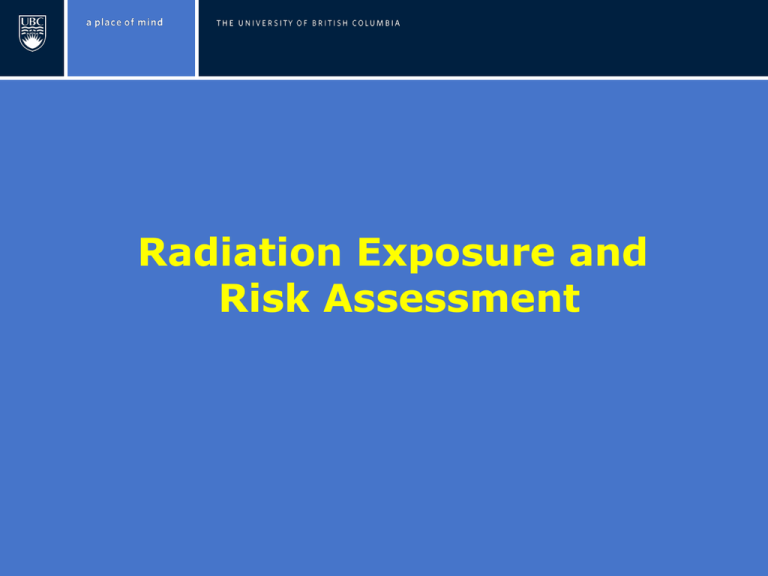
Radiation Exposure and
Risk Assessment
Maximum Permissible Dose
General Public
•
•
•
•
Whole Body
1 mSv/year
Skin
50 mSv/year
Hands Feet
50 mSv/year
Lens of the eye 15 mSv/year
Nuclear Energy Workers
Who is an NEW?
A worker who has a
REASONABLE PROBABILITY
of exceeding the 1 mSv
limit to the general public.
Registered with the RSO.
Maximum Permissible
Dose
Nuclear Energy Worker
•
•
•
•
Whole Body
50 mSv/year
Skin
500 mSv/year
Hands Feet
500 mSv/year
Lens of the eye 150 mSv/year
(CNSC)
Radiation Exposure of Women
Nuclear Energy Workers
• Whole Body Limit may not exceed
annual limit of 5 mSv
• Radiation exposure at the surface of the
abdomen may not exceed 4
declaration of pregnancy
mSv following
• Badges changed quarterly
Inform, Review, Reassign, Restrict
Radiation CANNOT
be:
•
•
•
•
•
Felt
Heard
Tasted
Smelled
Seen
Dosimetry
• External Personal Monitoring
–
–
–
–
–
Thermoluminescent dosimeters
Lithium Fluoride Crystals
Optically read dosimeters : LUXEL
Skin Dose
Body Dose
• Internal Personal Monitoring
• Bioassay
• Urine, saliva, sweat, feces
• Thyroid
• Difficult -distribution variability
Thermoluminescent Dosimeters
Landauer
Health Canada
Optically Read
Dosimeters
(Landauer)
Personal Alarm Dosimeter
Who MUST wear a TLD?
A NEW who has a REASONABLE PROBABILITY
of receiving a radiation exposure greater than
5mSv/year (CNSC)
1mSv/year – UBC action level
How do I estimate my dose?
Will I need to be monitored?
External Exposure Estimate
X
At
d
2
Where:
• X = Dose
(mSv)
• = Specific Gamma Ray Constant
• A = Activity (MBq)
• t = Time
(hours)
• d = Distance from Source (cm)
What is the radiation dose received by a
graduate student working with 185 MBq
of Na-22 for two hours per day for 22
days at a distance of 35 cm from the
source and using no shielding?
• X = Total Dose
• t = 44 hours
• = 3.24 (mSv*cm2)/(h*MBq) at
1 cm
• A = 185 MBq
• d = 35 cm
X=Γ At
(D)2
X = (3.24) (mSv*cm2)/(h*MBq) (185 MBq) (44h)
(35cm)2
X = 21.5 mSv
Who SHOULD NOT wear a TLD?
A NEW who has only a
REMOTE POSSIBILITY of receiving a
radiation exposure greater than 1mSv/yr.
Personnel working with low energy betas
such as S-35, C-14 and H-3.
External Exposure Estimate
X
At
d
2
• For gamma radiation
ESTIMATION OF EXTERNAL
β-RADIATION DOSE
NOT IN CONTACT WITH SKIN
•Rule of thumb, valid over a wide range of beta energies
Sv m 2 A
2
D 27
Bq hr d
Dose Rate (Sv/hr)
Activity (Bq)
Distance from
source (m)
•Assumes point source and no attenuation to air or source material
•Expect large errors beyond 1 m (overestimates absorbed dose)
Internal Exposure
Iodine – 125 , 131
Concentrate in thyroid
*CNSC regulation*
Contact HSE before using Iodine 125, 131
•Contact during planning stage
•Specific monitoring protocols are required
Question?
• A salesman is showing you a new piece of
equipment which has a radiation trefoil on
the side. He assures you that the
equipment is safe because it contains an
alpha emitter that has been shown to
produce 4 roentgens and is in a lead
sealed casing. He also tells you that other
users only report about 0.9 mS
per year…Will you buy it?
Section 3 - *B.E.I.R
7. Biological Effects of Ionizing
Radiation
*U.S. National Academy of
Sciences Reports
“Radium Girls”
B.E.I.R. Human
Experience
•
•
•
•
•
•
Early martyrs
Radium Dial Painters
Tuberculosis Patients
Survivors of Atomic Bombings
Ankylosing Spondylitis Patients
Uranium Miners – Elliot Lake, Ont.
Radiation Institute of Canada
Effects – Chronic vs. Acute
• Chronic: repeated doses of low levels of
radioactive materials
• Acute: single or short term doses at higher
levels
• Often use one to help understand the
other
Effects of Radiation:
Somatic or Genetic
• somatic if they become manifest in the
exposed person
– Non-reproductive cells
• genetic if they affect their descendants.
– Reproductive cells
Somatic Effects and Risk Factors
Age effects are important, age
independent risk estimates may be
inappropriate.
Diet, genetics, lifestyle factors can all
affect outcome
Synergistic effects may be important
eg. Uranium miners : smoking
Cancers induced by radiation are
indistinguishable from those caused
naturally
Solid tumours such as breast, lung,
thyroid and GI are greater numerically
than leukemia
Risk is greater for women - breast
and thyroid cancer
Cancer complex disease – no
guarantees
30 – 100 Trillion Cells at Risk
Different Cell Types
Different Cell Cycle
Different Cell Targets
End Effect of
Radiation
Organelle death
Cell death
Cell healing
Chromosome loss
Gene loss
Gene rearrangement
DNA Damage
Single Strand Break
Double Strand Break*
Change or Loss of Base
Bond BreakageUncoiling
Intra-Helix Crosslinking
Inter-Helix Crosslinking
Inter-Protein Crosslinking
Dicentric chromosomes
induced by radiation exposure
Unexposed
Exposed
LNT model: linear, no threshold Atomic bomb
victims*
Incidence of effects
*Chernobyl
Increasing Radiation Dose
Incidence
1
Incidence of Radium-Induced
Malignant Tumors
0.8
0.6
0.4
0.2
0
3.7 kBq
37 kBq
370kBq
3.7 MBq
Estimated Maximum Radium Burden in Bq
Incidence of effects
Atomic bomb
victims*
Threshold model
*Chernobyl
“Normal Exposure”?
Radiation Hormesis
Increasing Radiation Dose
Where does our radiation dose
come from?
Natural Sources:
Sky
100,000 Cosmic Neutrons /hr
400,000 Cosmic Gamma rays/hr
Soil and Building
200,000,000 Gamma rays/hr
Air
30,000 decays/hr
Alpha, Beta, Gamma
Food and Drink
15,000,000 K- 40/hr
7,000 Uranium/hr
12,240,000 C-14/hr
Dose Rates – Cosmic Rays
Altitude
μSv/hr
10 Km
5
6.7 Km
1
Whistler
0.1
Sea Level
0.03
Natural Annual Dose Rates
Estimated:
• Cosmic
• External
0.45
0.26
• Internal
0.27
• Other
<0.01
~1.0 mSv/ year
Sources of Total Radiation
Exposure in USA
Annual Dose Rates – Health Care
Medical X-rays
1.03
Dental X-rays
0.03
Nuclear Medicine
0.01
~1.1 mSv/ year
Maximum Permissible Doses
UBC Workers (members of public)
1 mSv per year
Nuclear Energy Workers (NEWs )
10 mSv per year
(UBC)
Engineer/Scientist
Med Lab Tech
Industrial Radiographer
Annual Dose Rates 1997
Dose Interval
mSv
Number of Workers Average Dose
0
4198
0.00
>0-1
516
0.32
>1-2
25
1.48
>2-5
6
3.37
>5-20
2
6.2
X=0.05 mSv
Canadian Exposures
Acute Effects
*2 Gy: cell depletion in bone marrow
*2-5 Gy : cataracts
*10 Gy: gastrointestinal syndrome
*20 Gy: central nervous system
Sv = Gy x QF
SV~Gy
(1 Gy = 100rads)
(QF = 1 for gamma)
Attempted theft of Co-60 source
3 weeks
8 weeks
Industrial Radiography
•Sealed radioactive sources: e.g. Iridium 192
•High activity: 58 curies = 2.1 TBq
WARNING:
Photo of gross anatomy
Viewer discretion advised.
Other uses for sealed radioactive sources:
-Internal calibration standards in liquid scintillation
counters (Cs- 137)
- Generation of ion current in electron capture devices
e.g. gas chromatographs (Ni-63)
*Inventory required for these instruments at UBC*
-Industrial uses:
volume measurement in closed vessels
thickness measurement gauges
food irradiation
soil density gauges
Nuclear Gauges
-Cs 137 : gamma source
density gauges
-Am241/Be: neutron source
moisture gauges
-Portable: may require TDG training
knowledge of regulations, documentation
Expect occupational exposure
-Safety through training: manual,
courses offered by manufacturer
INCIDENCE OF CANCER
BEIR VII – 2006
•Assuming an age/sex distribution similar to the
entire US population: 42/100 people will be
diagnosed with cancer = 42%
Acute exposure to 1.0 mSv radiation (above
background) could result in 1 new cancer
per ten thousand = 0.01%
(LNT model)
Risk of cancer after acute exposure to 1.0mSv
= 42.01%
ALARA Principle
As Low As Reasonably Achievable
Question?
• Does radiation effect the human body
through acute or chronic exposures?
• Why do TB patients have a higher incident
of breast cancer, but not lung cancer?
– Different susceptibilities to damage from
radiation
• Do sealed sources of radiation have any
risk associated with them?
– Yes – can still offer significant damage

